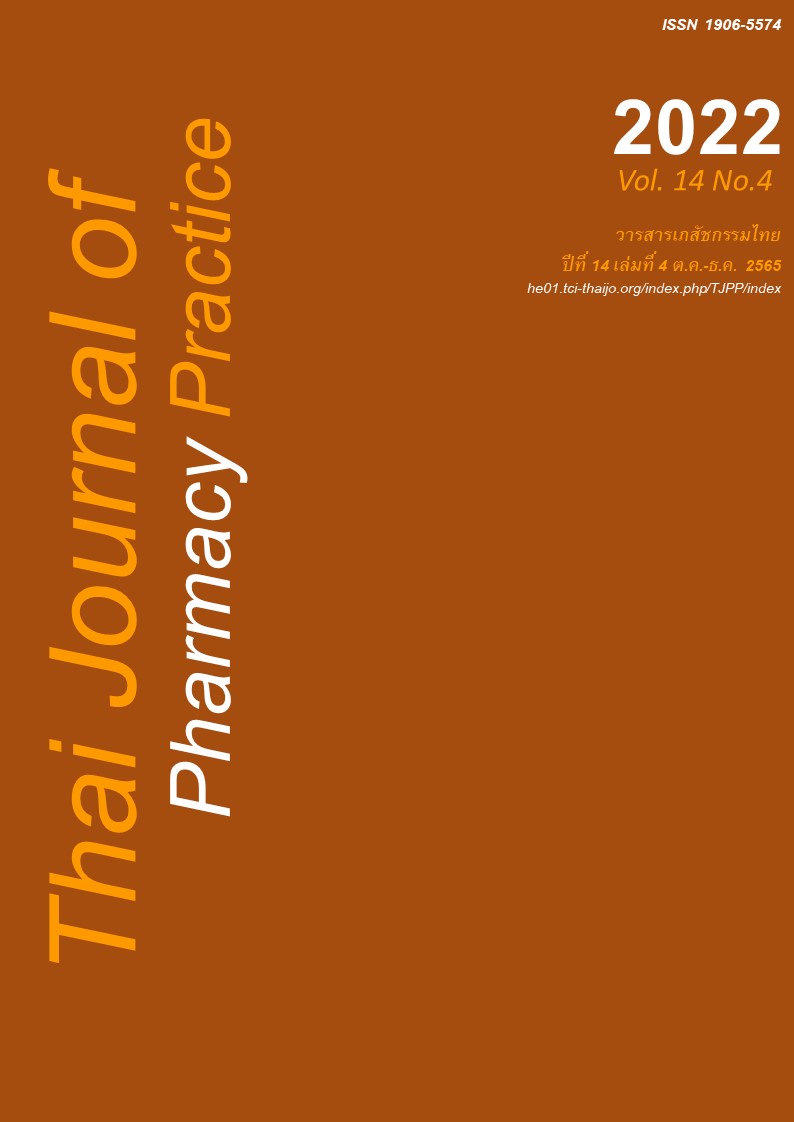ความเข้าใจด้านยาและความร่วมมือในการใช้ยาของผู้ติดเชื้อเอชไอวี/ผู้ป่วยเอดส์: กรณีศึกษาโรงพยาบาลแห่งหนึ่งในจังหวัดสกลนคร
Main Article Content
บทคัดย่อ
วัตถุประสงค์: เพื่อศึกษาความเข้าใจด้านยาและความร่วมมือในการใช้ยาของผู้ติดเชื้อไวรัสเอชไอวี/ผู้ป่วยเอดส์ และศึกษาความสัมพันธ์ระหว่างตัวแปรทั้งสอง วิธีการ: การวิจัยครั้งนี้เป็นการศึกษาแบบภาคตัดขวางในตัวอย่างที่เลือกมาแบบตามสะดวกจำนวน 280 คน ความร่วมมือในการใช้ยาประเมินด้วยการนับเม็ดยา ความเข้าใจด้านยาประเมินด้วยแบบสอบถามความเข้าใจด้านยาฉบับภาษาไทย (Thai Medication Understanding Questionnaire) ผลการวิจัย: ตัวอย่างส่วนมากมีความเข้าใจด้านยาอยู่ในระดับดี (คะแนนมากกว่าหรือเท่ากับ 5 คะแนน) ความร่วมมือในการใช้ยาเฉลี่ยอยู่ในระดับดี (ร้อยละ 97.75) การศึกษาพบความสัมพันธ์เชิงบวกระหว่างความเข้าใจด้านยาและความร่วมมือในการใช้ยา (P<0.05) การศึกษายังพบความสัมพันธ์ระหว่างปัจจัยส่วนบุคคลกับความเข้าใจด้านยา คือ อาชีพ ระยะเวลาในการกินยา การเกิดผลข้างเคียงจากยาต้านไวรัส ระดับเซลล์เม็ดเลือดขาว และปริมาณไวรัส (P<0.05) และพบความสัมพันธ์ระหว่างความร่วมมือในการใช้ยากับสิทธิ์การรักษา (P<0.05) สรุป: การศึกษาพบความสัมพันธ์ระหว่างความเข้าใจด้านยากับความร่วมมือในการใช้ยา และสามารถบอกถึงปัจจัยที่สัมพันธ์กับความเข้าใจด้านยาและความร่วมมือในการใช้ยา ผลการศึกษาสามารถนำไปพัฒนารูปแบบการดูแลผู้ป่วยให้ตระหนักถึงความสำคัญในการรับประทานยาเพื่อกดปริมาณไวรัสไว้ ซึ่งเป็นเป้าหมายสำคัญของการรักษาด้วยยาต้านไวรัส
Article Details

อนุญาตภายใต้เงื่อนไข Creative Commons Attribution-NonCommercial-NoDerivatives 4.0 International License.
ผลการวิจัยและความคิดเห็นที่ปรากฏในบทความถือเป็นความคิดเห็นและอยู่ในความรับผิดชอบของผู้นิพนธ์ มิใช่ความเห็นหรือความรับผิดชอบของกองบรรณาธิการ หรือคณะเภสัชศาสตร์ มหาวิทยาลัยสงขลานครินทร์ ทั้งนี้ไม่รวมความผิดพลาดอันเกิดจากการพิมพ์ บทความที่ได้รับการเผยแพร่โดยวารสารเภสัชกรรมไทยถือเป็นสิทธิ์ของวารสารฯ
เอกสารอ้างอิง
World Health Organization. Global health sector strategy on HIV 2016–2021 [online]. 2018 [cited Nov 10, 2018]. Available from: www.who.int/hiv/stra tegy2016-2021/ghss-hiv/en/
UNAIDs. UNAIDS data 2017 [online]. 2017 [cited Nov 12, 2018]. Available from: www.unaids.org/site s/default/files/media_asset/2017_data-book_en.pdf
UNAIDS. UNAIDS data 2018 [online]. 2018 [cited Nov 18, 2018]. Available from: www.unaids.org/site s/default/files/media_asset/unaids-data-2018_en.pdf
World Health Organization. Section I setting the scene [online]. 2003 [cited Dec 7, 2018]. Available from: www.who.int/chp/knowledge/publications/adhe rence_Section1.pdf
Long JM, Kee CC, Graham M V, Saethang TB, Dames FD. Medication compliance and the older hemodialysis patient. ANNA J 1998; 25: 43–9.
Bangsberg DR. Less than 95% adherence to non- nucleoside reverse-transcriptase inhibitor therapy can lead to viral suppression. Clin Infect Dis. 2006; 43: 939–41.
Mannheimer S, Friedland G, Matts J, Child C, Chesney M. The consistency of adherence to anti- retroviral therapy predicts biologic outcomes for human immunodeficiency virus–infected persons in clinical trials. Clin Infect Dis. 2002; 34: 1115–21.
Mhothong P, Thongkot W, Aungpanyasattawong S. Determining the sample size by the Yamane’s formula. DPU Res. :1–12.
Marvanova M, Roumie CL, Eden SK, Cawthon C, Schnipper JL, Kripalani S. Health literacy and medication understanding among hospitalized adults. J Hosp Med. 2011; 6: 488–93.
Srirach C, Boonshuyar C, Pacheun O. View of health behaviors and adherence to antiretroviral drug among people living with human immunedefi ciency virus. J Nursing Siam Univ 2018; 19: 39–55.
Hfocus. AIDs: epidemics with no vaccines [online]. 2020 [cited May 21, 2021]. Available from: /www. hfocus.org/content/2020/05/19271
March K, Mak M, Louie SG. Effects of pharma- cists’ interventions on patient outcomes in an HIV primary care clinic. Am J Heal Pharm. 2007; 64: 2574–8.
Saberi P, Dong BJ, Johnson MO, Greenblatt RM, Cocohoba JM. The impact of HIV clinical pharma- cists on HIV treatment outcomes: a systematic review. Patient Prefer Adherence 2012; 6: 297-322.
Paterson DL, Swindells S, Mohr J, Brester M, Vergis EN, Squier C, et al. Adherence to protease inhibitor therapy and outcomes in patients with HIV infection. Ann Intern Med. 2000;133: 21-30.
Hu Y. The Study of Type 2 Diabetes in China: Patient Medication Understanding and Medication Adherence; Physician Prescribing Patterns and Attitudes toward Traditional Chinese Medicine. J Med Assoc Thai 2020; 103(10): 1004-10.
Kripalani S, Laura E, Chiu Y, Robertson R, Kolm P, Terry A. Predictors of medication self-manage ment skill in a low-literacy population setting and population. J Gen Intern Med. 2006; 21: 852-6. doi: 10.1111/j.1525-1497.2006.00536.x.


